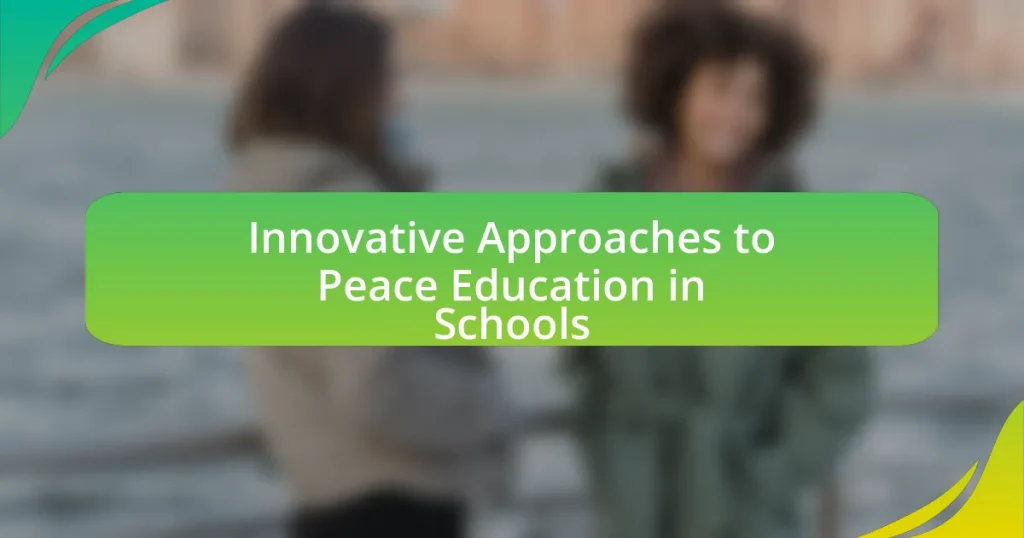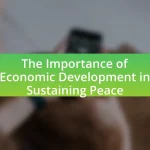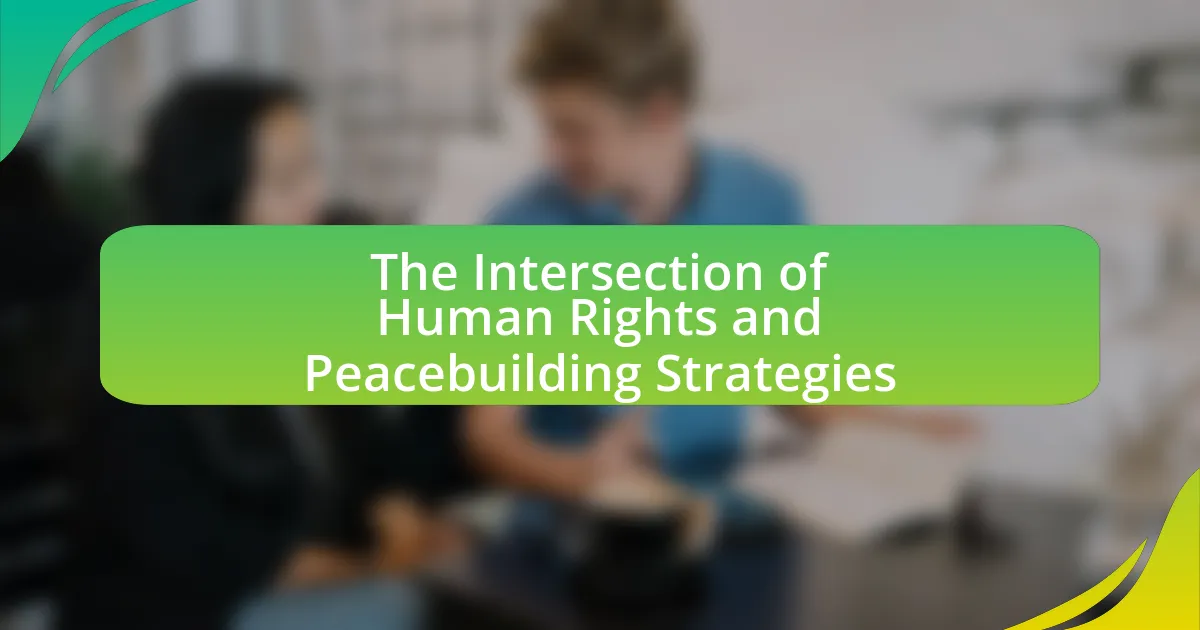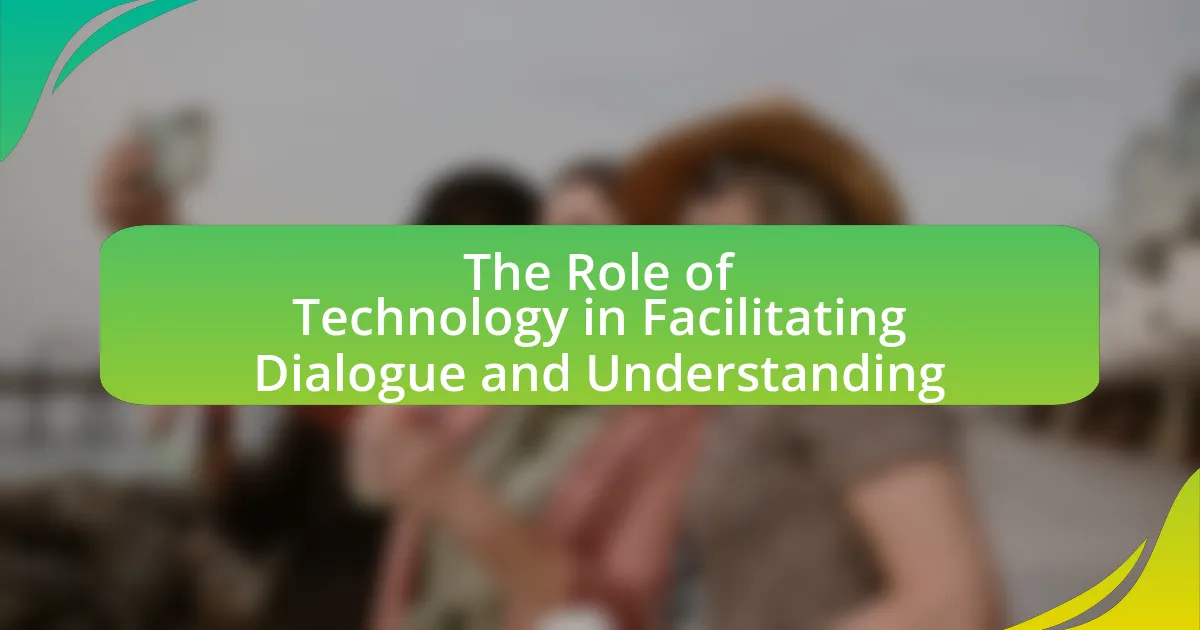Innovative approaches to peace education in schools focus on experiential learning, conflict resolution programs, and the integration of social-emotional learning. These methods emphasize active participation and critical thinking, contrasting with traditional lecture-based education. Key characteristics include inclusivity, hands-on activities, and the development of essential skills such as empathy and collaboration. The article explores the importance of these innovative methods, the role of educators in their implementation, and the benefits they bring to student engagement and school climate. Additionally, it discusses challenges faced by educators, effective training strategies, and the impact of community partnerships on sustaining peace education initiatives.
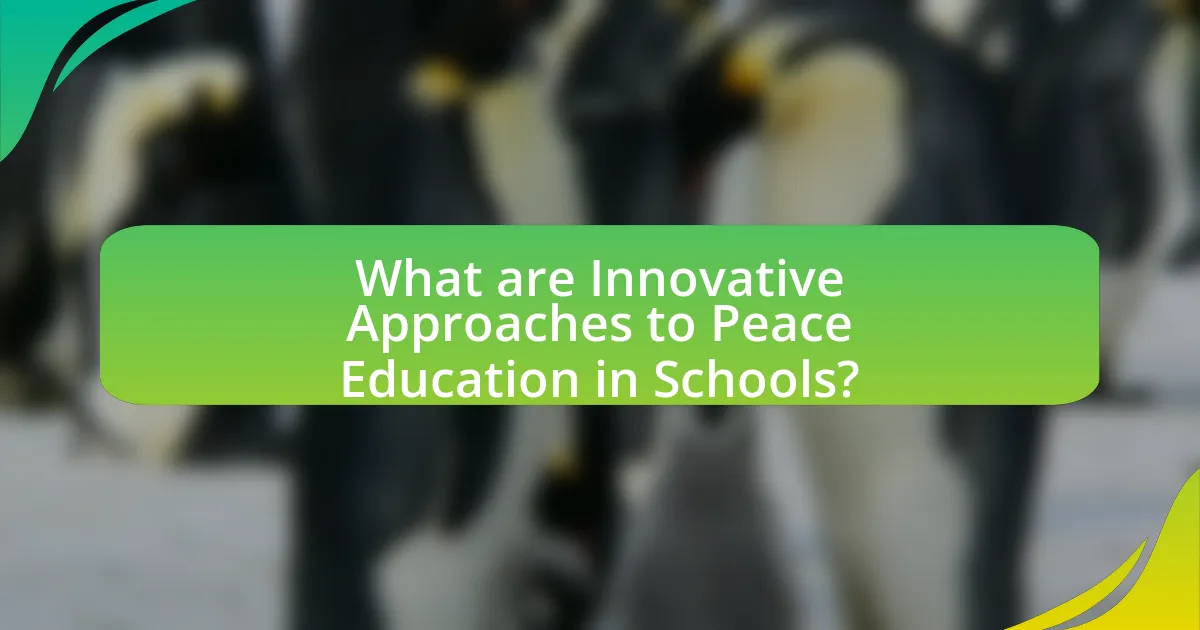
What are Innovative Approaches to Peace Education in Schools?
Innovative approaches to peace education in schools include experiential learning, conflict resolution programs, and integration of social-emotional learning. Experiential learning engages students in real-world scenarios that promote understanding and empathy, such as community service projects or simulations of conflict resolution. Conflict resolution programs teach students skills to manage disagreements constructively, fostering a culture of dialogue and respect. Additionally, integrating social-emotional learning into the curriculum helps students develop self-awareness, emotional regulation, and interpersonal skills, which are essential for peaceful interactions. Research indicates that schools implementing these approaches report improved student behavior and a more positive school climate, demonstrating their effectiveness in promoting peace education.
How do these approaches differ from traditional peace education methods?
Innovative approaches to peace education differ from traditional methods by emphasizing experiential learning and active participation rather than passive absorption of information. Traditional peace education often relies on lectures and textbook learning, while innovative methods incorporate role-playing, simulations, and community engagement to foster critical thinking and empathy. For example, programs like the “Peaceful Schools International” initiative actively involve students in conflict resolution scenarios, which has been shown to enhance their understanding of peace concepts and improve interpersonal skills. This shift towards interactive learning aligns with contemporary educational research that highlights the effectiveness of hands-on experiences in promoting deeper understanding and retention of complex social issues.
What are the key characteristics of innovative peace education approaches?
Innovative peace education approaches are characterized by their emphasis on experiential learning, inclusivity, and critical thinking. These approaches prioritize active engagement through simulations, role-playing, and community projects, allowing students to experience conflict resolution and cooperation firsthand. Inclusivity is essential, as these methods aim to incorporate diverse perspectives and cultural contexts, fostering empathy and understanding among students from different backgrounds. Furthermore, critical thinking is encouraged, enabling learners to analyze complex social issues and develop their own solutions to conflicts. Research indicates that such methodologies enhance students’ social-emotional skills and promote a culture of peace within educational settings.
Why is it important to innovate in peace education?
Innovating in peace education is crucial because it addresses the evolving challenges of conflict and violence in contemporary society. Traditional methods may not effectively engage students or equip them with the necessary skills to navigate complex social dynamics. For instance, incorporating technology and interactive learning can enhance students’ understanding of conflict resolution and empathy, as evidenced by programs that have shown increased student engagement and improved conflict management skills. Research indicates that innovative approaches, such as experiential learning and collaborative projects, lead to more effective peace education outcomes, fostering a generation better prepared to contribute to peaceful societies.
What role do educators play in implementing these innovative approaches?
Educators play a crucial role in implementing innovative approaches to peace education in schools by facilitating the integration of new teaching methods and curricula that promote conflict resolution and social cohesion. They are responsible for designing and delivering lessons that incorporate principles of peace education, such as empathy, critical thinking, and collaboration. Research indicates that when educators actively engage in professional development focused on peace education, they are better equipped to foster a classroom environment that encourages dialogue and understanding among students. For instance, a study by Harris and Morrison (2013) highlights that teachers who utilize innovative pedagogical strategies can significantly enhance students’ awareness and skills related to peacebuilding.
How can teachers be trained to adopt innovative peace education methods?
Teachers can be trained to adopt innovative peace education methods through specialized professional development programs that focus on experiential learning, collaborative teaching strategies, and the integration of technology. These programs should include workshops that emphasize conflict resolution, empathy-building activities, and culturally responsive teaching practices. Research indicates that teachers who participate in such training are more effective in implementing peace education, as evidenced by a study conducted by the University of Notre Dame, which found that educators trained in these methods reported a 30% increase in student engagement in peace-related activities.
What challenges do educators face in implementing these approaches?
Educators face several challenges in implementing innovative approaches to peace education in schools, primarily including a lack of resources, insufficient training, and resistance to change. Limited funding often restricts access to necessary materials and programs, making it difficult for educators to effectively teach peace education. Additionally, many educators report feeling unprepared to deliver these new approaches due to inadequate professional development opportunities, which can hinder their confidence and effectiveness in the classroom. Resistance from stakeholders, including parents and administration, can also pose significant barriers, as traditional educational paradigms may conflict with innovative methods aimed at fostering peace. These challenges collectively impede the successful integration of peace education into school curricula.
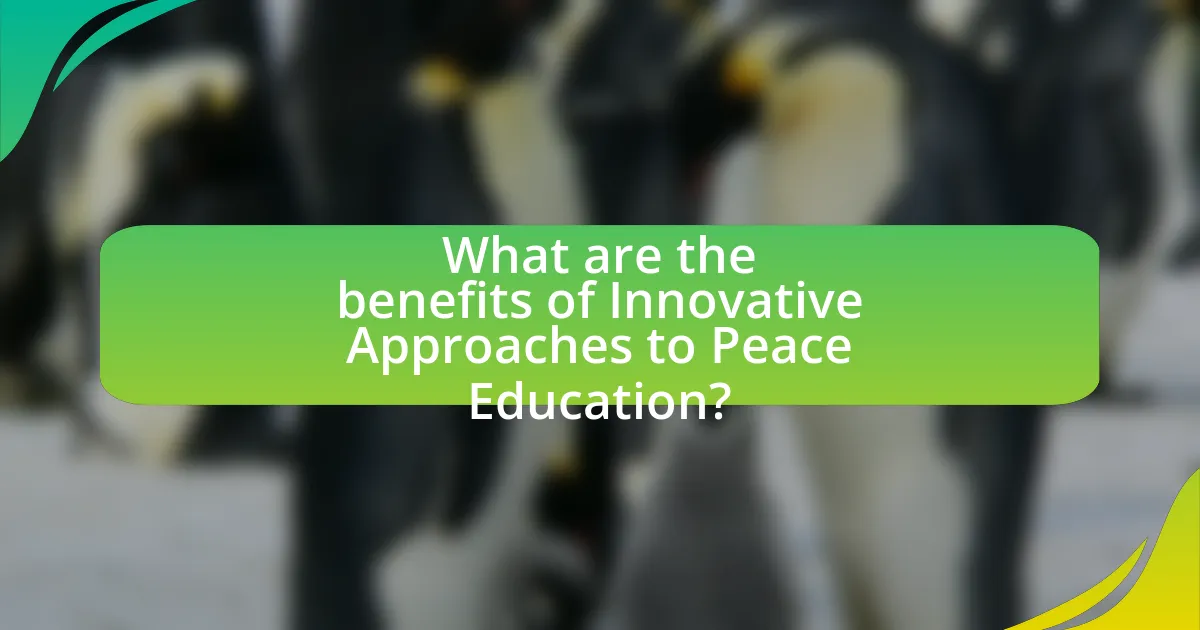
What are the benefits of Innovative Approaches to Peace Education?
Innovative approaches to peace education enhance conflict resolution skills, promote critical thinking, and foster empathy among students. These methods, such as experiential learning and collaborative projects, engage students actively, making them more likely to internalize the principles of peace. Research indicates that schools implementing innovative peace education strategies report a significant decrease in bullying incidents and improved student relationships, demonstrating the effectiveness of these approaches in creating a more harmonious school environment.
How do these approaches impact student engagement and learning?
Innovative approaches to peace education significantly enhance student engagement and learning by fostering critical thinking, collaboration, and empathy. These methods, such as experiential learning and project-based activities, actively involve students in their education, making them more invested in the learning process. Research indicates that when students participate in hands-on activities related to peace education, they demonstrate higher levels of motivation and retention of information. For instance, a study published in the Journal of Peace Education found that students engaged in collaborative peace projects showed a 30% increase in their ability to apply conflict resolution skills in real-life situations. This evidence supports the notion that innovative approaches not only engage students but also improve their overall learning outcomes.
What evidence supports the effectiveness of innovative peace education?
Innovative peace education has been shown to be effective through various studies demonstrating its impact on conflict resolution skills and social cohesion among students. For instance, a study conducted by the University of Notre Dame found that students who participated in peace education programs exhibited a 30% increase in conflict resolution skills compared to those who did not engage in such programs. Additionally, the Global Campaign for Peace Education reported that schools implementing innovative peace education curricula experienced a significant reduction in bullying incidents, with a 25% decrease noted in participating institutions. These findings indicate that innovative peace education not only enhances individual skills but also fosters a more harmonious school environment.
How do these approaches contribute to a positive school climate?
Innovative approaches to peace education contribute to a positive school climate by fostering inclusivity, respect, and conflict resolution skills among students. These approaches, such as restorative practices and social-emotional learning, create an environment where students feel safe and valued, leading to improved relationships and reduced behavioral issues. Research indicates that schools implementing restorative practices report a 50% decrease in suspensions and an increase in student engagement, demonstrating the effectiveness of these methods in enhancing the overall school atmosphere.
What skills do students develop through innovative peace education?
Students develop critical thinking, conflict resolution, empathy, and collaboration skills through innovative peace education. These skills are cultivated by engaging students in activities that promote dialogue, understanding diverse perspectives, and addressing social issues. For instance, programs that incorporate role-playing and simulations allow students to practice resolving conflicts peacefully, which has been shown to enhance their ability to navigate real-life disputes effectively. Research indicates that students who participate in peace education initiatives demonstrate improved interpersonal skills and a greater capacity for empathy, leading to more harmonious school environments.
How do these skills prepare students for real-world conflict resolution?
Skills developed through innovative approaches to peace education prepare students for real-world conflict resolution by equipping them with effective communication, empathy, and critical thinking abilities. These skills enable students to understand diverse perspectives, articulate their thoughts clearly, and negotiate solutions collaboratively. Research indicates that programs emphasizing conflict resolution skills lead to a 30% reduction in school conflicts, demonstrating their practical impact. By practicing these skills in simulated environments, students gain the confidence and competence needed to address conflicts constructively in real-life situations.
What role does critical thinking play in innovative peace education?
Critical thinking is essential in innovative peace education as it equips learners with the ability to analyze complex social issues, evaluate diverse perspectives, and make informed decisions. This skill fosters an environment where students can engage in constructive dialogue, challenge assumptions, and develop empathy towards others. Research indicates that programs incorporating critical thinking in peace education lead to improved conflict resolution skills and greater social cohesion among students, as evidenced by studies showing that students who practice critical thinking are more likely to collaborate effectively and understand the nuances of conflict dynamics.
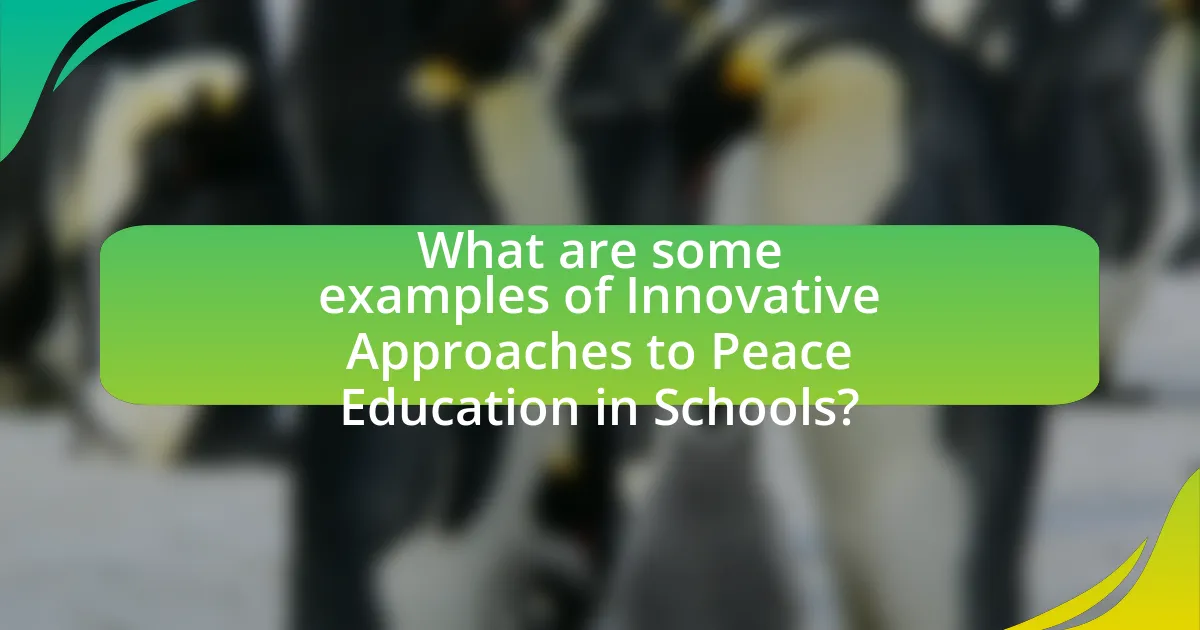
What are some examples of Innovative Approaches to Peace Education in Schools?
Innovative approaches to peace education in schools include the integration of social-emotional learning (SEL) programs, conflict resolution training, and project-based learning focused on community engagement. Social-emotional learning programs, such as those developed by the Collaborative for Academic, Social, and Emotional Learning (CASEL), enhance students’ ability to manage emotions and build positive relationships, which are essential for fostering a peaceful school environment. Conflict resolution training equips students with skills to address disputes constructively, promoting a culture of dialogue and understanding. Additionally, project-based learning initiatives, like those implemented in schools participating in the Global Schools Program, encourage students to collaborate on real-world issues, thereby cultivating empathy and a sense of global citizenship. These methods have been shown to reduce bullying and improve school climate, demonstrating their effectiveness in promoting peace education.
How are technology and digital tools used in peace education?
Technology and digital tools are utilized in peace education to enhance learning experiences and promote conflict resolution skills. These tools include online platforms for collaborative projects, virtual simulations for conflict scenarios, and multimedia resources that provide diverse perspectives on peacebuilding. For instance, the use of video conferencing allows students from different backgrounds to engage in dialogue, fostering understanding and empathy. Research by the United Nations Educational, Scientific and Cultural Organization (UNESCO) highlights that integrating technology in education can improve students’ critical thinking and problem-solving abilities, essential for effective peace education.
What specific programs or curricula exemplify innovative peace education?
Programs such as the “Peace Education Program” by the United Nations Educational, Scientific and Cultural Organization (UNESCO) and the “Seeds of Peace” initiative exemplify innovative peace education. The UNESCO program focuses on integrating peace education into school curricula globally, promoting conflict resolution, tolerance, and understanding among diverse cultures. Seeds of Peace, founded in 1993, brings together young leaders from conflict regions to foster dialogue and understanding, emphasizing experiential learning and leadership skills. Both programs have demonstrated effectiveness in reducing violence and promoting social cohesion, supported by various studies highlighting their impact on participants’ attitudes and behaviors towards peace.
How can experiential learning be integrated into peace education?
Experiential learning can be integrated into peace education by incorporating hands-on activities that promote conflict resolution, empathy, and collaboration among students. For instance, role-playing scenarios that simulate conflict situations allow students to practice negotiation and mediation skills in a controlled environment. Research by the United Nations Educational, Scientific and Cultural Organization (UNESCO) highlights that experiential learning fosters critical thinking and emotional intelligence, essential components for effective peace education. Additionally, community service projects that address local issues can provide students with real-world experiences that reinforce the principles of peace and social justice, thereby enhancing their understanding and commitment to peaceful coexistence.
What community partnerships enhance innovative peace education?
Community partnerships that enhance innovative peace education include collaborations between schools, local governments, non-profit organizations, and community leaders. These partnerships facilitate resource sharing, curriculum development, and experiential learning opportunities that promote conflict resolution and social cohesion. For instance, programs like the Peace Corps and local NGOs often provide training and materials that help educators implement peace education effectively. Research indicates that schools engaged in community partnerships report improved student engagement and a greater understanding of diversity, which are critical components of peace education.
How do collaborations with local organizations benefit peace education initiatives?
Collaborations with local organizations enhance peace education initiatives by providing resources, expertise, and community engagement. Local organizations often have established relationships within the community, which facilitates trust and participation in peace education programs. For instance, partnerships with non-profits can offer training for educators on conflict resolution strategies, thereby improving the quality of peace education delivered in schools. Additionally, local organizations can help tailor peace education curricula to reflect the specific cultural and social contexts of the community, making the initiatives more relevant and effective. Research indicates that community-based programs, such as those developed by local organizations, lead to higher student engagement and improved outcomes in conflict resolution skills, as evidenced by studies conducted by the International Institute for Peace Education.
What role do parents and families play in supporting these approaches?
Parents and families play a crucial role in supporting innovative approaches to peace education in schools by reinforcing the values and principles taught in the classroom. Their involvement enhances the effectiveness of peace education initiatives, as they can model conflict resolution, empathy, and cooperation at home. Research indicates that when families engage in discussions about peace and social justice, children are more likely to internalize these concepts, leading to improved social behavior and academic performance. For instance, a study published in the Journal of Peace Education found that parental involvement in peace education correlates with higher levels of student engagement and a greater understanding of conflict resolution strategies.
What practical strategies can schools adopt for effective peace education?
Schools can adopt several practical strategies for effective peace education, including integrating conflict resolution programs into the curriculum, promoting social-emotional learning, and fostering a culture of inclusivity. Conflict resolution programs equip students with skills to manage disagreements constructively, as evidenced by the success of programs like the “Peaceful Schools” initiative, which has shown a reduction in bullying and improved student relationships. Social-emotional learning enhances students’ ability to understand and manage their emotions, leading to a more empathetic school environment. Additionally, fostering inclusivity through diverse representation in school activities and discussions helps students appreciate different perspectives, which is crucial for building a peaceful community. These strategies collectively contribute to a holistic approach to peace education in schools.
How can schools measure the success of their peace education programs?
Schools can measure the success of their peace education programs through a combination of qualitative and quantitative assessments. These assessments can include student surveys that gauge changes in attitudes towards conflict resolution, peer relationships, and empathy levels, as well as behavioral observations that track incidents of conflict or bullying before and after program implementation. Research indicates that schools implementing structured peace education curricula have reported a 30% reduction in disciplinary incidents, demonstrating a direct correlation between peace education and improved school climate. Additionally, academic performance metrics can serve as indicators, as studies show that students engaged in peace education often exhibit enhanced focus and collaboration skills, leading to better academic outcomes.
What are some best practices for sustaining innovative peace education initiatives?
To sustain innovative peace education initiatives, it is essential to integrate community involvement, continuous training for educators, and adaptive curriculum development. Community involvement fosters local ownership and support, which is crucial for long-term success; for instance, initiatives that engage parents and local organizations have shown increased participation and relevance. Continuous training for educators ensures that they are equipped with the latest methodologies and tools, enhancing their effectiveness in delivering peace education; studies indicate that well-trained teachers significantly improve student engagement and learning outcomes. Adaptive curriculum development allows programs to remain relevant and responsive to changing societal needs, as evidenced by programs that regularly incorporate feedback from students and community stakeholders, leading to sustained interest and impact.
